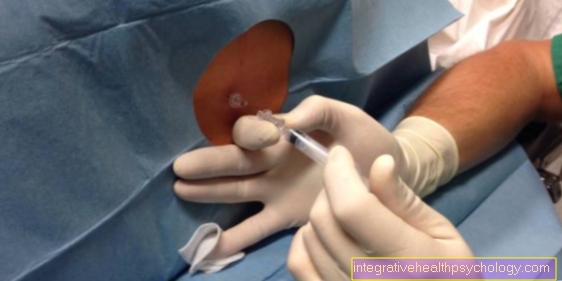Sedation
introduction
The word sedation comes from the Latin word sedare, which means to soothe or calm down.
This also shows what is meant by medical sedation.
The person concerned should be calmed down by medication and their stress, physically and mentally, reduced.
For this effect, sedatives, i.e. sedating drugs, have to dampen the central nervous system.
In contrast to general anesthesia, the person concerned usually breathes independently and can often also be woken up.
The sedation can also be supplemented by painkillers, in technical language analgesics.
This is then referred to as analgesic sedation.
The most common sedatives are the benzodiazepines and the antidepressants.
Sedation is used to calm down before and during medical interventions, such as colonoscopies and dental surgeries, and also to calm down mental illnesses.
Intensive care patients are also often sedated, as otherwise they would not be able to withstand the stress of intensive care.
Long-term use of sedatives can lead to habituation and require larger amounts of the medication.
The calming effect of sedation can dampen the respiratory drive and the circulatory system so much that drug therapy and monitoring are necessary.
In some cases, sedatives lead to paradoxical states, that is, those affected become restless.

In which areas is sedation used?
Sedation has very different areas of application, all of which require the person concerned to calm down.
Many patients receive premedication from anesthesia before surgery.
This is a low-dose sedating drug that reduces tension and fear of the procedure.
During a medical intervention under regional anesthesia, anxious or restless sufferers can also be given sedating medication in order not to be aware of the intervention.
Examples of such interventions or examinations are colonoscopies and dental surgeries.
Both procedures do not have to be performed under general anesthesia, but they are very stressful for the person concerned.
In intensive care units, patients are often sedated to create tolerance for ventilation.
In addition, stress and restlessness have a negative effect on the recovery of intensive care patients and should therefore be avoided.
Another area of application of sedation is calming down mentally ill people.
Sedation may be necessary in both acute psychosis and suicidality.
Sedatives are also used in so-called qualified alcohol withdrawal to reduce withdrawal symptoms.
Use at the dentist
A visit to the dentist is associated with great anxiety and stress for many people.
For most procedures, local anesthesia is the only anesthesia the patient receives.
This leads to the elimination of the pain, but not to a loss of consciousness.
Those affected will be aware of the entire procedure.
The noises and pressure in the mouth area as well as the taste of blood can make those affected restless and thus make the dentist's work more difficult.
Particularly anxious patients, but also children, people with dementia or mentally impaired people can also be soothed with sedating medication.
If medically necessary, this sedation is also paid for by health insurance companies.
This applies particularly to children and patients who are otherwise unable to give their consent.
After a dental procedure under sedation, the person concerned should be picked up and not drive alone for the rest of the day.
Depending on the length of the procedure, different medications are used for sedation.
Sedatives are not pain relievers, so the person affected should also be provided with pain relievers and given them before the anesthesia has subsided.
During the operation of the wisdom teeth
Surgical removal of wisdom teeth is a relatively major dental procedure.
The removal can also only be done under regional anesthesia, which, however, means a lot of stress for the body and is therefore carried out in two appointments.
When removing all four wisdom teeth at the same time, many dentists recommend sedation in order to reduce stress both physically and mentally.
For this, the person concerned is given a sedative, usually benzodiazepines, injected through a venous access.
In this case, sedation is only paid for by the health insurance company for minors.
Sedation during colonoscopy
A colonoscopy was previously described by many people as a terrible experience, which made them fearful of the procedure.
Today, the experience reports after colonoscopies are much more positive and those affected report that they slept through the procedure.
This is due to the fact that sedation is almost always performed today.
Those affected hardly notice the sometimes painful procedure and are much calmer.
Sedation for colonoscopies is usually covered by health insurance companies.
Is sedation used in MRIs?
The MRI is one of the imaging procedures that doctors can use to get an overview of certain organs.
The examination is completely painless.
During an MRI scan, however, the person affected must lie very still so as not to produce any blurring in the image.
Since children and mentally handicapped people often do not manage to lie still, sedation can be used in these cases.
Sedation may also be necessary for people who fear tight spaces.
MRIs are often performed, especially in children, as they do not cause any radiation exposure.
What is the difference between sedation and twilight sleep?
Twilight sleep is a certain state of consciousness that is triggered by sedative medication.
Sedation is a broader term.
Sedation begins with the use of certain antidepressants or premedication before surgery.
It is a dampening of the central nervous system, i.e. the brain.
This can range from slight tiredness to the point of general anesthesia.
The different states of consciousness are determined with point values.
Most doctors use the Richmond Agitation Scale for this, which assigns a certain point value to the behavior of the person concerned.
The twilight sleep is only one or two points below the awake patient.
In twilight sleep, the person concerned can be awakened when spoken to or has his eyes open all the time.
The state of consciousness can be influenced by the choice of medication and the dosage.
For most interventions, twilight sleep is sufficient to calm you down.
Which side effects can occur?
Sedative medication calm the sufferer both physically and mentally.
This effect can overshoot the actually defined goal.
In the case of antidepressants, this means that those affected not only become calm but also sleepy.
In medical procedures, this can mean the difference between twilight sleep and anesthesia.
Sedatives also work on blood pressure, heart rate, and respiratory drive.
If the dosage is too high, breathing can stop and the circulation collapses, as both areas are downregulated.
In this case, the affected person must be ventilated and the circulation must be stabilized with medication.
With antidepressants, a possible side effect is a cardiac arrhythmia, which should be detected by regular ECG checks.
Many sedatives also cause nausea and vomiting when taken for the first time.
Some sedating drugs are also addictive.
This means that initially there is a habituation effect in which those affected need ever higher doses, and later the affected person becomes physically and psychologically dependent on the medication.
However, these are side effects that only occur with long-term use.
You might also be interested in this topic: General anesthesia for a cold
How much does sedation cost?
Sedation for medical interventions or diagnostic procedures costs around 75 euros per half hour or part thereof.
However, those affected do not always have to pay these costs themselves.
The medical necessity is important here.
The health insurance pays premedication before operations.
Sedation during a colonoscopy is also a health insurance benefit.
Sedation during a dental procedure depends on the patient's age.
For minors, sedation is covered by the health insurance fund.
Adult patients have to bear the costs themselves, depending on the procedure.
Some health insurance companies offer their patients additional services and also do not assume any statutory costs.
Those affected should inquire about this with their health insurance company before an operation.
Compared to general anesthesia, sedation is the more cost-effective alternative and at the same time has fewer side effects.
The necessary local anesthesia, which is also performed on sedated patients, is always a health insurance benefit.
These drugs are used
There are many different groups of drugs that can be used for sedation.
The first group are the benzodiazepines.
These include diazepam, lorazepam, midazolam and many more.
The benzodiazepines are classified according to their duration of action.
Benzodiazepines have a quick onset of action.
The next group of sedative drugs are the antidepressants, which include doxepin and amitriptyline.
These are normally used to dampen an increased stress level to a normal level and not for dampening operations.
Another group of drugs are the narcotics, such as thiopental, ketamine and propofol.
These can be used in low doses for sedation and in higher doses for general anesthesia.
The group of neuroleptics also has a sedating effect.
Neuroleptics such as haloperidol are given to dampen psychotic states in particular.
The strong pain relievers from the opioid group, such as morphine or fentanyl, also have a sedative effect.
Other groups are barbiturates and antihistamines.
Herbal remedies can also be used for light sedation.
These include valerian, lemon balm, passion flower and real St. John's wort.
Benzodiazepines are almost always the method of choice for short interventions.
How St. John's wort works as a popular medicinal plant, read in our article: This is how St. John's wort works
Dormicum
Dormicum is a trade name for the active ingredient midazolam and is therefore a benzodiazepine.
Midazolam is one of the short-acting benzodiazepines and is therefore preferred for premedication before operations and for short procedures.
It promotes sleep and has a calming effect.
In emergency medicine, midazolam is used to buffer the side effects of the pain reliever ketamine.
A continuous infusion with midazolam can be used for long-term sedation in intensive care medicine.
Midazolam is not recommended in late pregnancy and breastfeeding mothers.
Sedation in children - this should be noted
Children need sedation for diagnostic procedures such as an MRI or brief interventions more often than adults.
This is simply because children do not yet understand the need for a measure and therefore do not hold still.
Children have a different metabolism than adults depending on their age, so the dosage of sedating medication cannot simply be calculated down to body weight.
Small children often need significantly higher doses to achieve the same effect as adults.
Many sedating drugs are already approved in infancy.
Some benzodiazepines can not only be administered through a venous line, but can also be administered through the nasal mucosa or as a suppository, which already reduces the children's fear of sedation.
For all sedative procedures in children it must be ensured that a doctor who is experienced with child intubation and venous access in children is present.
The equipment in the various departments, such as radiology, must allow emergency care for the child.
So-called paradoxical reactions to benzodiazepines are more common in children than in adults, and the children become restless and anxious.
In this case, an alternative to sedation with benzodiazepines must be available.
All further information about anesthesia in children can be found in the following article: Anesthesia in children - procedure, risks, side effects
Sedation despite a cold?
A mild cold is not a contraindication for sedation.
In the case of febrile infections, however, interventions that are not medically necessary should be postponed.
In emergencies, sedation is also possible during a febrile infection.
If you have a severe cold, the airways can be irritated and swollen, making intubation difficult in an emergency.
However, this is still possible with necessary procedures.
Sedation During Pregnancy?
Some sedating drugs cross the placenta and breast milk.
This means that the medication not only affects the mother, but also the child.
Benzodiazepines, the most frequently used sedatives, are only to be used in late pregnancy and breastfeeding if absolutely necessary, as they can lead to breathing problems and poor drinking in the newborn.
Different drugs are problematic at different times during pregnancy.
In the last trimester, sedation with nitrous oxide can be performed as this has not shown any clinical damage to the child.
What are the alternatives to sedation?
For some people, sedation is not feasible for various reasons.
This can be due to pregnancy or at the request of the patient, for example.
Many interventions that are performed under sedation can also be performed under regional anesthesia.
In the case of dental treatments or gastroscopy, sedation is only one way of making the procedure fear-free and stress-free, but not necessary.
If necessary, such as standing still during the MRI, general anesthesia can replace sedation.
In contrast to sedation, general anesthesia means that the person concerned has to be ventilated and continuous monitoring of the circulatory system is necessary.
In addition to medicinal sedation, hypnosis or behavioral support during surgery is also possible.



























.jpg)

